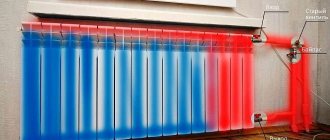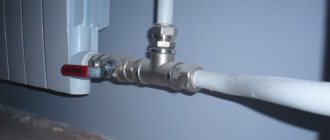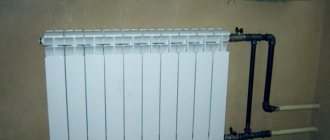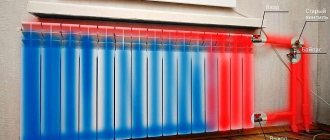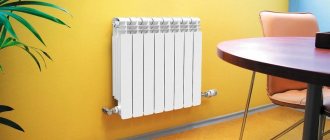Happy owners of new apartments, residents of housing who have made major repairs and decided to abandon the services of centralized heating, are awaiting the arrival of cold weather with some caution and apprehension. Many people ask one question. How to turn on the heating in your apartment if you do all the necessary work to install autonomous heating yourself? Are the radiators connected correctly, will the new, independent heating system in the apartment work normally in the future?
Your comfort and living conditions in the apartment depend on how correctly the new heating system is installed in the apartment and how the heating equipment is installed.
How to turn on the radiator correctly for the first time
A very important point is to turn on the central heating battery for the first time in your home. When a long period of time has passed, and the thermal power plant begins to supply water to our batteries, then usually the first water flowing through the heating systems is the dirtiest and rustiest. Imagine. You have just installed a brand new battery, one might say, off the assembly line, and suddenly a powerful stream of dirt is thrown in there. It is not surprising that many batteries become clogged precisely from the first such inclusion, and then we are surprised that out of 12 battery bends, only 8 are heated, the rest remain cold. To prevent this from happening, a jumper (bypass) is needed when installing the battery. If you have done the installation correctly, then set the position of the ball valves as shown in the figure:
In this case, the entire flow of dirt when turned on for the first time will go through the jumper, keeping your battery intact and safe. In this option, it is better to keep hot water running for several days. Of course, many are looking forward to when it will be turned on. However, my advice is, if you can’t wait a few days, wait at least one day. By the way, here is a detailed article on how to turn off the battery.
Expert advice
Experts advise that during the heating season, in order to shut off radiators, it is mandatory to use the following devices:
- ball valves;
- bypass with valve;
- drainer;
- thermostat;
- device for removing excess gas.
To learn how to bleed air from a radiator in a multi-story building, see the video below.
For many people, the heating system is a mystery. After all, it consists of rather complex pipe circuits that are interconnected by batteries in each residential apartment. Therefore, if the pipeline breaks down, everyone living in the house will suffer. That is why every person wants to know how to turn off a heating radiator so that not a single apartment is damaged.
How to regulate heat in batteries
Suppose you put a battery of 10 bends in the room, and you feel good with it when it’s -20 degrees outside. But now, the cold has passed and now it’s been -2 degrees for several days. Hot water, as often happens with us, at the same temperature continues to flow through our pipes in a powerful stream and a gas chamber is formed in the room, from which there is no escape. In this case, the temperature regulator comes to the rescue. There are many of them in nature. In the picture below you see one of them.
What brand of thermostat should be is the topic of a separate article. And now it is important for you and me to understand the principle. The figure shows one of the simplest thermostats. It has a knob on top that you can rotate and set values from 0 to 5:
5 - means that the entire flow of hot water will pass through the battery; 4, 3, 2, 1 - means that the regulator will reduce the diameter of the flow pipe, providing less hot water flow through the battery per unit time. Thus, at 4 the battery will be colder, at 3 even colder, etc.
If you want to disconnect the battery altogether, you can set it to “*” - the water current will be very small. Practically it will not exist:
Or you can simply close the ball valves on the battery. The effect will be approximately the same:
If you have 2 windows in your room and 2 radiators under them, then during installation it is advisable to install them wisely. For example, you need 20 sections for the entire room. Then it is better to put, for example, 12 sections on one battery, and 8 sections on the other. In this case, in addition to the regulator on each battery, you can completely turn off or turn on 8, 12 or all 20 sections at the same time.
Very important information
Below we will describe situations when one or another inclusion of the battery may be undesirable, and sometimes unacceptable!
By reading my blog, you are probably making repairs.
this page to your bookmarks . This is where all the useful home improvement stores are located.
| Not every plumbing store sells heating regulators. Here is a fairly powerful catalog with a large selection of thermostats, which can be filtered by price and manufacturer. |
4.1.You cannot use the thermostat without a jumper
In point 2 we talked about the thermostat. However, you need to understand that experiments with a temperature controller are only possible with a jumper! If it is not there, and you reduce the diameter of the flow pipe, then the total flow of hot water through your apartment will decrease. Which of course is unacceptable, otherwise your neighbors will come to you!
4.2. The thermostat may become clogged
If you are using a jumper, but for some reason it was turned off for a while and the thermostat was set to position 5, i.e. provided a full flow of hot water only through the battery, as shown in the figure:
then everything seems to be fine. However, we must accept reality as it is. Even if we turned on the central heating radiators correctly for the first time, there is no guarantee that, for example, in a month or two a new mud flow will not pass through the pipes. But then, if the jumper is turned off, then the splash of dirt will go straight to your thermostat, which, in fact, is very sensitive to it. As a result, a blockage forms in the thermostat, and water will not flow into the battery at all. It won’t go into the jumper either, because you closed it. Therefore, in this situation, water will stop flowing through your apartment; in the house, through your heating riser, the water will also stop and begin to cool in the cold. As a result, a squad of evil neighbors, together with the chairman of the HOA or housing cooperative, is guaranteed to enter your apartment.
Why do you need to make adjustments?
The main factors explaining the need to change the heating level of batteries using locking mechanisms and electronics:
- Free movement of hot water through pipes and inside radiators. Air pockets may form in the heating system. For this reason, the coolant stops heating the batteries, as it gradually cools. As a result, the indoor microclimate becomes less comfortable, and over time the room cools down. To maintain heat in the pipes, shut-off mechanisms installed on radiators are used.
- Adjusting the temperature of the batteries makes it possible to reduce the cost of heating your home. If the rooms are too hot, by changing the position of the valves on the radiators you can reduce costs by 25%. Moreover, reducing the heating temperature of the batteries by 1°C provides savings of 6%.
- In cases where radiators heat up the air in the apartment very much, you have to open the windows often. It is not advisable to do this in winter, because you can catch a cold. To avoid having to constantly open windows in order to normalize the microclimate in the room, regulators should be installed on the batteries.
- It becomes possible to change the heating temperature of radiators at your discretion, and individual parameters are set in each room.
Temperature standards
When it is possible to regulate the temperature in the radiators, it is important to be able to correctly determine in what cases and how much it is necessary to reduce or, conversely, increase the temperature in the apartment. The main thing is not to make it too hot or too cold.
You need to learn to determine a comfortable temperature for yourself.
You need to learn how to quickly determine what temperature will be most comfortable for living. SNiP can help in determining the optimal temperature for an apartment. For corner rooms, the best temperature is a little more than +20°C, but for all other rooms, on the contrary, a little less than this value. Knowing this, the owner of the apartment can change the air temperature in his rooms without any problems and feel quite comfortable.
How to regulate radiators
To influence the microclimate in the apartment, you need to reduce the volume of coolant passing through the heating device. In this case, it is only possible to reduce the temperature value. The heating system is adjusted by turning the valve/faucet or changing the parameters of the automation unit. The amount of hot water passing through the pipes and sections is reduced, and at the same time the battery heats up less intensely.
To understand how these phenomena are interconnected, you need to learn more about the operating principle of the heating system, in particular, radiators: hot water entering the heating device heats the metal, which, in turn, releases heat into the air. However, the intensity of heating the room depends not only on the volume of hot water in the battery. The type of metal from which the heating device is made also plays an important role.
Cast iron has a significant mass and releases heat slowly. For this reason, it is not advisable to install regulators on such radiators, since the device will take a long time to cool. Aluminum, steel, copper - all these metals instantly heat up and cool down relatively quickly. Work on installing regulators should be carried out before the start of the heating season, when there is no coolant in the system.
In an apartment building, there is no way to change the average water temperature in the heating system pipes. For this reason, it is better to install regulators that allow you to influence the microclimate in the room in a different way. However, this cannot be realized if the coolant is supplied from top to bottom. In a private house there is access and the ability to change individual equipment parameters and coolant temperature. This means that in this case it is often impractical to mount regulators on batteries.
Disabling radiators without fittings
It is no secret that in most apartments to this day there are old cast iron radiators or steel convectors without any shut-off fittings, which makes it impossible to shut them off during the heating season. Moreover, according to the old heating scheme, convectors in high-rise buildings are connected to risers without straight sections - bypasses. Therefore, if an accident occurs with a coolant leak, you must act as follows:
- Try to provide some kind of container to collect hot water. If the stream flows to the side, wrap a thick cloth over the break site so that the water flows along it into a bucket.
- Call the dispatch service of your heating energy supply company and report the accident.
- While the service personnel are getting there, provide them with access to the basement, find the keys, open the door, and so on.
- Try to block the riser yourself.
While your water is flowing onto the floor, your neighbors’ suspended ceiling turns into a bubble
A few words about how to properly turn off the heating riser. Find in the basement the heating point of your entrance and vertical pipes embedded in a large-diameter main or into a common collector. Follow where they go to determine the emergency riser, and turn it off with a tap. Contact by cell phone someone in the household who can confirm that the geyser eruption in the apartment has stopped. If you couldn’t find your pipe, close all the valves one by one until you find the one you need.
Attention! Don't try to force yourself on basement valves that are stuck due to rust. When they cannot be closed manually, it is better to wait for a team of plumbers; they will find a way to stop the flow of coolant. Otherwise, a very awkward situation will arise when you also break the main fittings, leaving the apartment building without heat during repairs
Otherwise, a very awkward situation will arise when you also break the main fittings, leaving the apartment building without heat during repairs.
Example of an access heating point and riser connection
It is also worth considering the question of how to shut off the battery if it is hot in the apartment due to the service provider’s failure to comply with the temperature schedule of the boiler room. It would seem that if there are shut-off valves, the problem is solved by manually closing the taps. But after the temperature in the rooms drops, the valves will have to be opened again. This way you will get tired of turning the taps long before the end of the heating season, so you need to think about how you can adjust the heat output of the radiators. The options are:
- if possible, install a thermostatic valve on each radiator, limiting the flow of coolant and automatically maintaining the set temperature in the room;
- It is nice to cover the heating device with a blank screen with small holes if there are no shut-off valves on the connections.
Important. The ball valve is not a means of adjustment; it is intended only to completely cut off or open the passage of the coolant. In the “half closed” mode it will not give the desired effect and will fail much earlier
In the “half closed” mode it will not give the desired effect and will fail much earlier.
Thanks to worn-out pipelines, district heating systems are notorious for dirty water that quickly clogs small passages. Therefore, ordinary valves with thermal heads will not last long here; you need to buy special valves with increased capacity, which are produced by the well-known brands Danfoss and Herz. How to install them on the connection to the radiator is shown below in the diagram and described in this material.
Radiator thermostat installation diagram
When it’s hot in an apartment in the middle of winter and there are no control valves, residents have no choice but to cover the radiator in the room with a decorative screen. The principle is simple: the radiator will heat the air inside the box, after which the intensity of heat transfer will sharply decrease due to the small difference in the temperatures of the air and the surface. That is, the coolant will give off less energy, and the amount of hot air coming out from under the screen will be limited by the size of the decorative openings. How to assemble and install a nice MDF box on a heating device is shown in the video:
Valves and taps
Such fittings are a heat exchanger of a shut-off device. This means that the radiator is adjusted by turning the tap/valve in the desired direction. If you turn the fittings 90° all the way, the flow of water into the battery will no longer flow. To change the heating level of the heating device, the locking mechanism is set to the half position. However, not every fitting has this opportunity. Some faucets may leak after a short period of use in this position.
Installing shut-off valves allows you to manually regulate the heating system. The valve is inexpensive. This is the main advantage of such fittings. In addition, it is easy to operate, and changing the microclimate does not require special knowledge. However, there are also disadvantages to locking mechanisms, for example, they are characterized by a low level of efficiency. The battery cooling rate is slow.
Stopcocks
A ball design is used. First of all, it is customary to install them on a heating radiator in order to protect housing from coolant leakage. This type of valve has only two positions: open and closed. Its main task is to turn off the battery if such a need arises, for example, if there is a risk of flooding of the apartment. For this reason, shut-off valves are cut into the pipe in front of the radiator.
Automatic adjustment
The advantage of this method is that there is no need to constantly change the position of the valve/faucet. The desired temperature will be maintained automatically. Adjusting the heating in this way makes it possible to set the desired parameters once. In the future, the heating level of the battery will be maintained by an automation unit or other device installed at the input of the heating device.
If necessary, individual parameters can be set multiple times, which is influenced by the personal preferences of the residents. The disadvantages of this method include the significant cost of components. The more functional the devices are for controlling the amount of coolant in heating radiators, the higher their price.
Electronic thermostats
These devices superficially resemble a control valve, but there is a significant difference - a display is built into the design. It displays the room temperature that needs to be obtained. Such devices work in conjunction with a remote temperature sensor. It transmits information to the electronic thermostat. To normalize the microclimate in the room, you just need to set the desired temperature value on the device, and the adjustment will be performed automatically. Electronic thermostats are located at the battery input.
Adjusting radiators with thermostats
Devices of this type consist of two units: lower (thermal valve) and upper (thermal head). The first of the elements resembles a manual valve. It is made of durable metal. The advantage of such an element is the ability to install not only an automatic, but also a mechanical valve, it all depends on the needs of the user. To change the heating temperature of the battery, the design of the thermostat provides a bellows, which exerts pressure on the spring-loaded mechanism, and the latter, in turn, changes the flow area.
Using Three-Way Valves
Such devices are made in the form of a tee and are intended for installation at the connection point of the bypass, the inlet pipe to the radiator, or the general riser of the heating system. To increase operating efficiency, the three-way valve is equipped with a thermostatic head, the same as that of the previously discussed thermostat. If the temperature at the valve inlet is higher than the desired value, the coolant does not enter the battery. Hot water is directed through the bypass and passes further along the heating riser.
When the valve cools down, the passage hole opens again and the coolant flows into the battery. It is advisable to install such a device if the heating system is single-pipe and the pipe distribution is vertical.
Setting methods
Not every residential building has adjustable heating radiators; moreover, their installation in many cases may simply be impossible. For example, control valves cannot be installed if the building has a vertical top distribution, i.e. when heat is supplied from above. Consequently, it is always too hot on the upper floors, and apartment owners even have to open their windows wide. At the same time, on the lower floors of the battery it is a little colder.
If the building has a single-pipe system, this problem does not arise, since the water, after passing through the radiators, returns back to the central riser. Thanks to this, warm air is evenly distributed throughout the rooms, regardless of what height they are at - be it on the first floor or on the twentieth. At the same time, the batteries have control valves on the supply pipe.
The best option for supplying heat and the ability to regulate it is a two-pipe heating system. It has separate pipes both for supplying heated water and for returning it to the system. In this case, the radiators in each room are regulated separately, because each of them has special valves.
By regulating the heat supply, you can create comfort and significantly reduce heating costs
The main goal pursued when adjusting heat supply is to achieve a certain air temperature in the room. This can be achieved in one of two ways:
- High quality . The method involves changing the quality of water. To do this, you need to have some influence on its heating.
- Quantitative . When using it, it is necessary to change the speed at which water is supplied. This is done through a circulation pump or a locking mechanism. If the volume of water supplied is reduced, this will help lower the temperature. If, on the contrary, you increase the water flow rate, the room will become warmer.
If the building has high-quality equipment, it is possible to use two methods simultaneously.
Recommendations for installing devices
To be able to regulate the temperature of the battery in the apartment, consider any type of valve: they can be straight or angular. The installation principle of such a device is simple; the main thing is to correctly determine its position. Thus, the direction of coolant flow is indicated on the valve body. It must correspond to the direction of water movement inside the battery.
Place valves/thermostats at the inlet of the heating device; if necessary, install a tap at the outlet as well. This is done so that in the future it will be possible to independently drain the coolant. Regulating devices are installed on heating radiators, provided that the user knows exactly which pipe is the supply pipe, since a tap is made into it. In this case, the direction of movement of hot water in the riser is taken into account: from top to bottom or from bottom to top.
Compression fittings are more reliable, which is why they are used more often. The connection to the pipes is threaded. Thermostats can be equipped with a union nut. To seal the threaded connection, use FUM tape or flax.
Happy owners of new apartments, residents of housing who have made major repairs and decided to abandon the services of centralized heating, are awaiting the arrival of cold weather with some caution and apprehension. Many people ask one question. How to turn on the heating in your apartment if you do all the necessary work to install autonomous heating yourself? Are the radiators connected correctly, will the new, independent heating system in the apartment work normally in the future?
Your comfort and living conditions in the apartment depend on how correctly the new heating system is installed in the apartment and how the heating equipment is installed.
Balancing a central heating system
During normal operation of the heating network, all radiators should receive the same heat. But if the radiators are not balanced correctly, then at the beginning of the chain the radiators will be too hot, and at the end they will be barely warm.
Let's look at how we can solve this problem. In order to control the flow of liquid through the system, it is necessary to install a double adjustment valve on each heating device. Moreover, if you close some of the valves at the beginning of the chain, you can ensure a more uniform distribution of hot water.
In order to properly balance the system, it is necessary to turn off the heating, allow the water to cool and open the valves on all batteries. To do this, remove the covers from them and turn them on using pliers.
Next, turn on the heating and go to the first battery in the circuit, regulate it and then, alternately balance the others
If they don’t know the order, then when turning on the system, pay attention to their heating
It is important! Thermometers for radiators are installed on the return and supply pipes. Close the valve and then gradually open it again until there is a difference of 10°C between the thermometer readings (20°C Fahrenheit)
The same is repeated with all radiators included in a particular circuit. The result is a balanced and efficient heating system.
Do not be surprised if the valve on the last radiator is completely open, since for good heating of the room, uniform operation (heating) of the entire system is necessary.
For efficient operation of the heating system and for high-quality heating of the room, it is necessary to balance the operation of the circuit. To do this, it is better to invite specialists who will quickly and efficiently complete this task, and if you want to do everything yourself, but do not know how to properly adjust the radiators, then read the instructions and the nuances of the work.
- Bimetallic heating radiators: a new word in the world of heat
- Floor heating radiator - a step towards modern living space design
- The main differences between the installation of water heated floors and other home heating systems
- How to correctly use mats for heated water floors during installation
The main problem that will have to be solved by switching to your own heating system in the apartment
All repair and technical work with elements of the heating system in apartments must be carried out before the onset of cold weather, when the heating season has not officially begun. It is during this period that it is time to reconstruct the heating in the house. The absence of coolant in the central heating system will allow shutdown without problems. Dismantling of old pipes and radiators can be carried out without fear of disrupting the operation of the main life support systems of an apartment building. Moreover, when there is official permission to refuse the services of centralized city heating and hot water supply.
How to properly replace old batteries with new radiators, how to connect a gas or electric boiler. It all depends on how technically prepared you are for such a step. All such work requires a competent technical solution, taking into account the seriousness of the problem. You live in an apartment building, you are surrounded by strangers. Any defect in the operation of the new heating can lead to dire consequences. The figure shows an ideal diagram of the equipment of an autonomous heating system.
